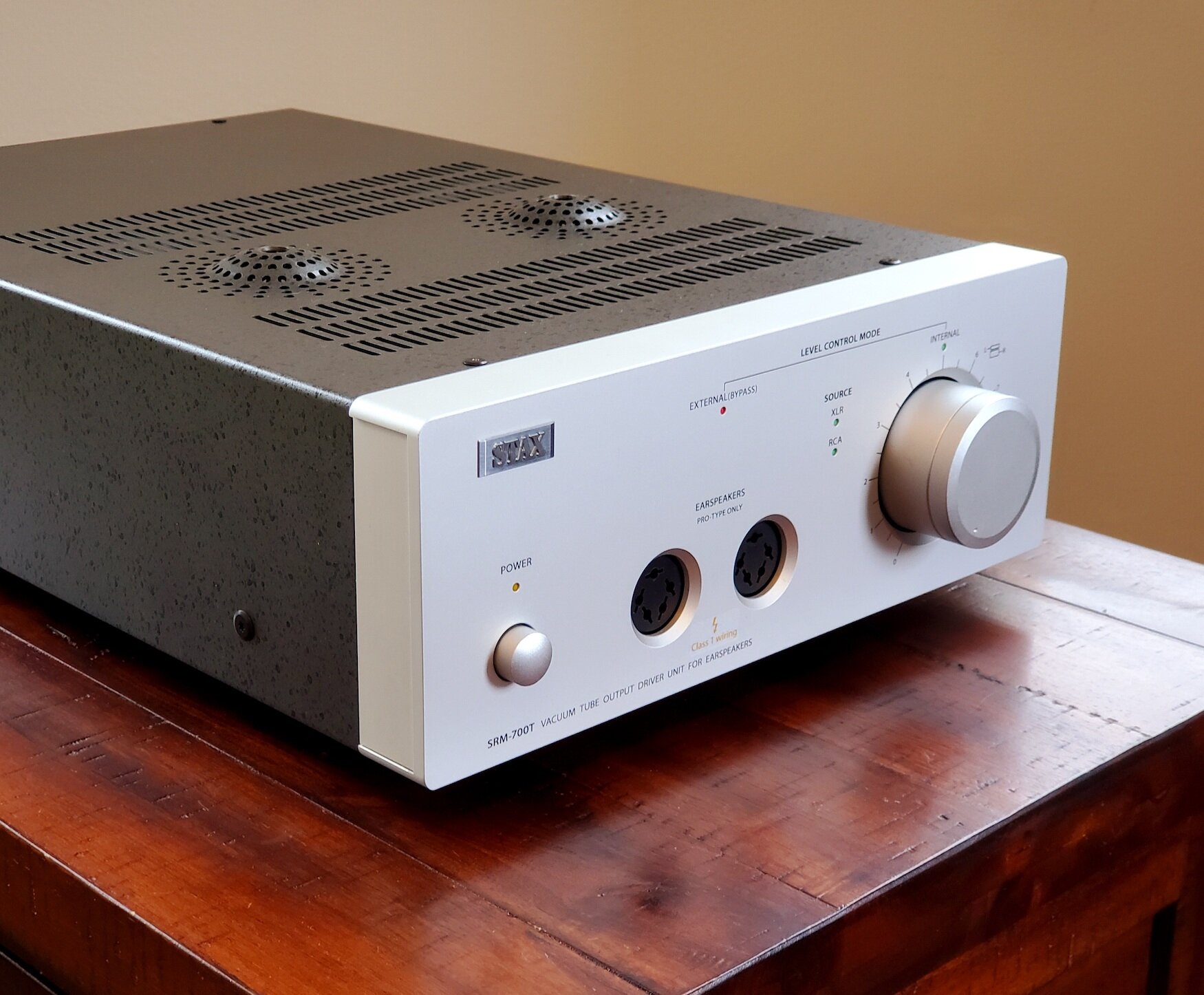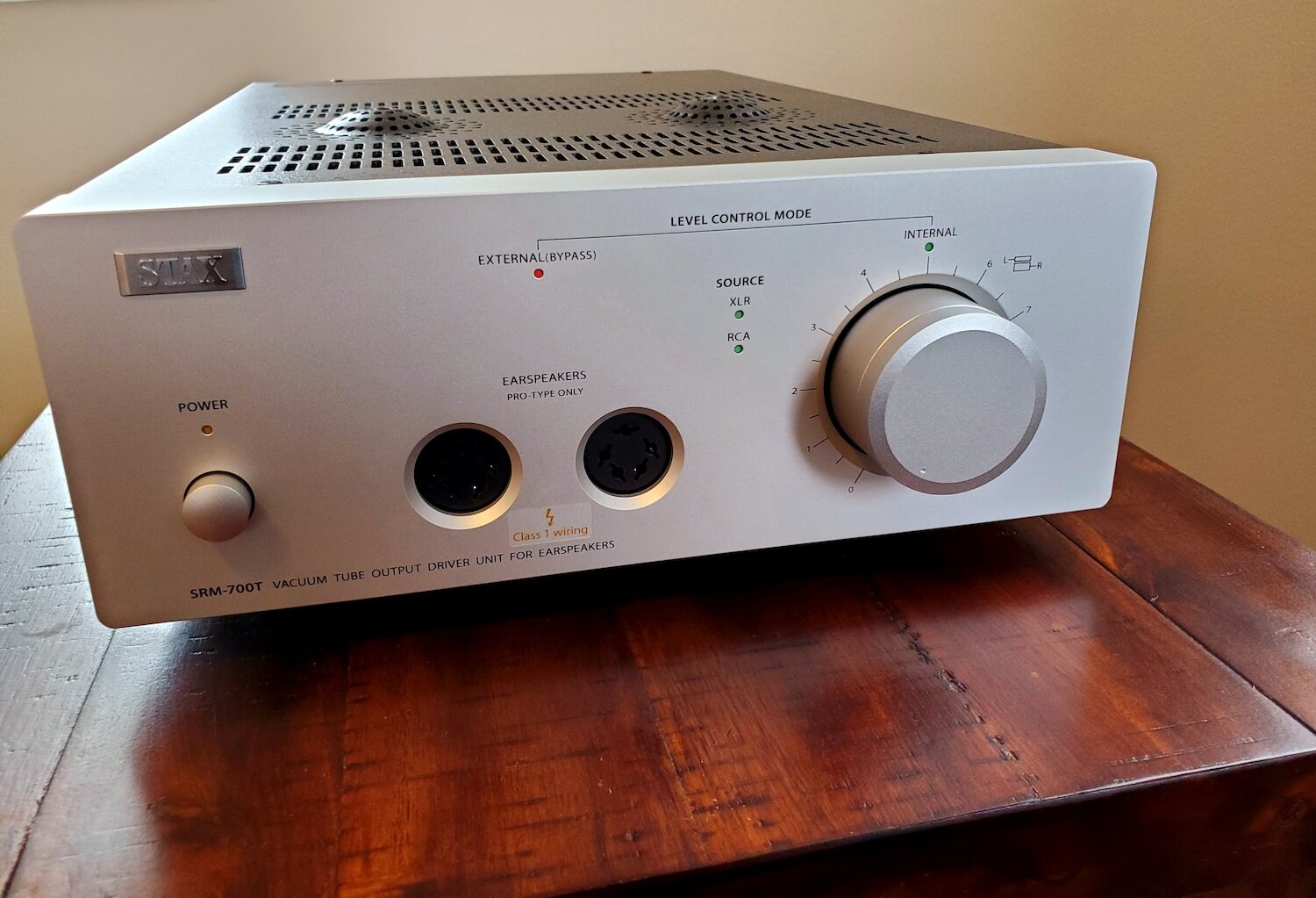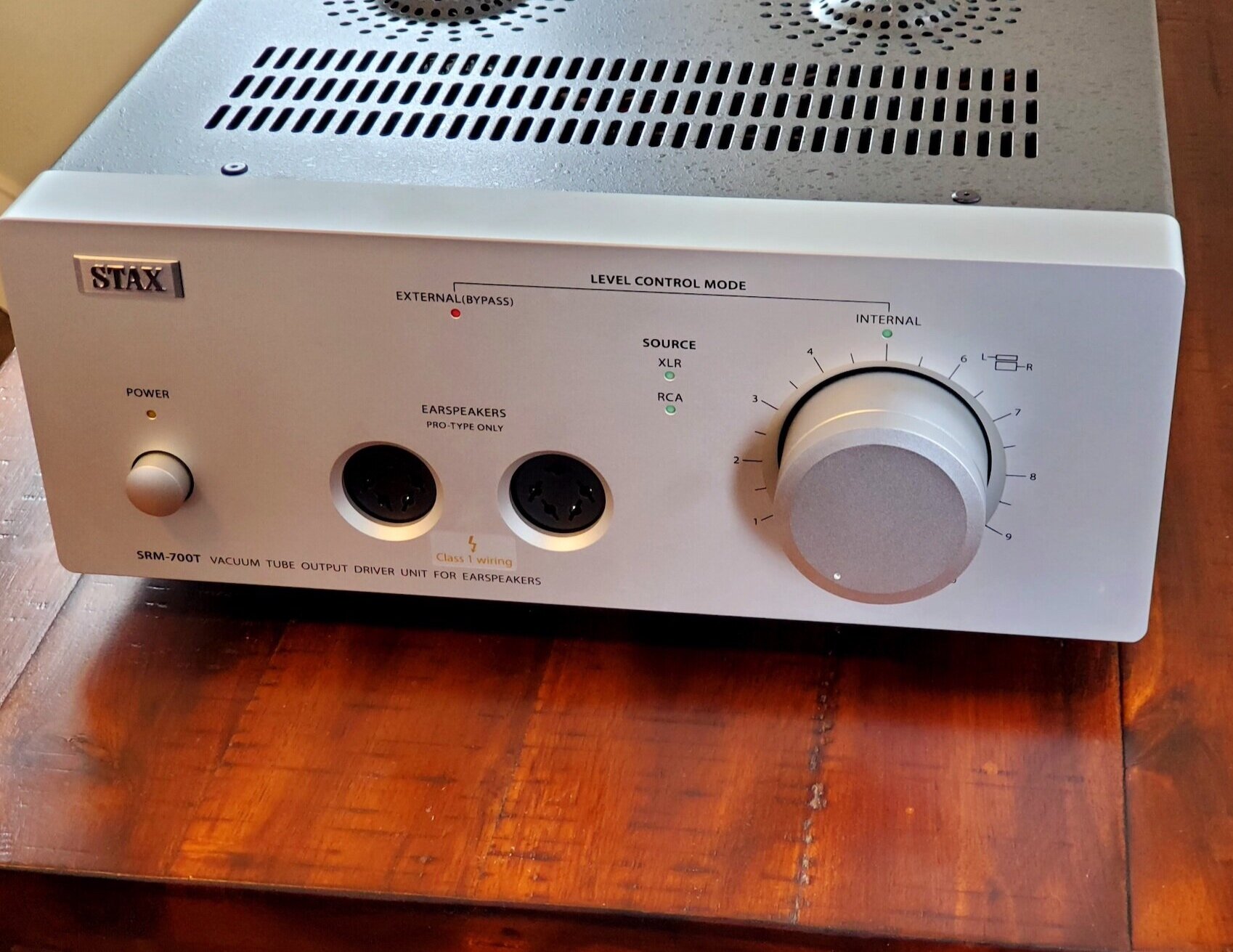A TUBED ELECTROSTATIC MUSICAL BEAUTY!
Those who have followed my latest reviews are very much aware of how the world of electrostatic earspeakers (headphones) and electrostatic energizers (headphone amplifiers) have affected me. And they have provided for a series of musical epiphanies that have not been subtle. This has left the audio cynic in me reeling!
For an historical perspective on STAX, please read any of the previous reviews—STAX SR-L700MkII, SR-007A, SR-009S—as I will not belabor the point for readers already familiar with the historical narrative on the STAX company. It is, however, quite interesting and insightful. STAX is, after all, a nearly 100 year old company!
I will first say, that I did not expect much from the SRM-700T given its “power” tube compliment of 2-6SN7s, which are not traditional power tubes. And the 6SN7 powered amplifiers that I have actually heard, did not sound very good at all and that would be the kindest thing that I could say about them.
Upon receipt of the STAX SRM-700T, I unpackaged it (sorry, no video), set it up on its own elevated stand, plugged it into the system—Border Patrol SE-i DAC, Roon Nucleus+, and STAX SR-007A earspeakers—powered it via wall plug, and pressed “on.” As it was a demo, burn-in was not required. I did, however, let the STAX SRM-700T cook for several hours to stabilize, after its rather long international trip.
A few hours later I pressed play. I believe there was an exclamation—Yikes! You’re kidding me, not again?! I have to tell you folks, STAX is doing me in, they just keep bringing it and my thesaurus is taking a beating! What is apparent is that those nearly 100 years in business have brought incredible insight, worldly wisdom, and top notch audio-know-how.
This brings us to the review of the STAX SRM-700T a hybrid—tubed and solid state—electrostatic headphone energizer or headphone amplifier, that is able to power all 5-pin-equipped, electrostatic headphones. And impedance and sensitivity are not an issue, at all for this energizer/headphone amplifier. Once more into the breach then? But, of course. This is, after all, electrostatics that we’re talking about.
REFRAIN: Unlike most reviews, this review will be non-sequential, as it will start, below, with how the equipment actually sounds and not the process of physically “undressing” it and/or laying out its various parts, specifications, etc. Think of this review then, as a non-linear movie—Memento, Kill Bill, Arrival, Eternal Sunshine of the Spotless Mind, The Terminator, In the Shadow of the Moon, The Queen’s Gambit, etc—that, likewise, starts at the end and winds its way to the beginning.
Disclaimer: I have no financial interest, stock, bonds, etc. in STAX and I stand to gain nothing. I’m just telling it like I hear it!
THE SOUND
The consistency of STAX’s earspeakers and their ability to transparently render the music, regardless of genre as well as the venue—small studio, cathedral roots, orchestral hall, etc.—is unparalleled. This is to say, that you’ll be able to see deeply in to the soundstage and across its breadth, wherein you will find undiscovered nuance, oceans of microscopic detail and cues, and, as a result, a great listening experience. There is, of course, the blistering transient speed for which electrostatics are known and the incredible realism that rises into existence, track after track, as a result of their collective traits.
STAX SRM-700T as accompaniment by the various STAX earspeakers—STAX SR-L700MkII, SR-007A, SR-009S—on hand embodied sublime “MFEO”—Made for Each Other—synergy—which improves noticeably, as one climbs the STAX earspeaker line. Suffice to say, that any of the combinations would be a stark revelation for those who’ve not heard a STAX electrostatic earspeaker and a STAX electrostatic energizer (amplifier) together. Again, if you’re a music lover, then this is a bucket list item must.
The SRM-700T paired exceptional well with the Border Patrol SE-i, which made incredibly beautiful music, reminiscent of a golden, sunlit dusk, while also giving new life to previously unlistenable media. And then there was the AudioNet DNP whose neutrality and speed, weight and propulsive energy allowed the duo to ride dynamic shifts as though the shifts were saddled and bridled. The Mola Mola Tambaqui brought it all together in combination with the STAX SRM-700T rendering an incredible naturalness and even greater transparency. This trio acted more as a time and space machine, transporting this listener from venue to venue, with supreme ease and beauty.
The STAX SRM-700T, as mentioned above, is a hybrid design, which means it employs both solid state and tube stages. In this respect, the SRM-700T delivers what tube amps are, in general, known for—an intoxicating and beguiling musicality and dimensionality—three-dimensional space. And it delivers, as well, what is characteristic of solid state designs—tighter control of the bass, a more detailed or more resolute depiction of the music in question, and exceptional dynamics.
I’ve owned a great many tube amplifiers in my decades long search for musical nirvana—Air Tight, Audiomat, Conrad Johnson, Jadis, McIntosh, Rogue Audio, Viva, etc.—and the STAX SRM-700T fits in very well with the best of them.
The STAX SRM-700T’s volumetric cube—its soundstage—is vast and encompassing and it will fix entertainers and musicians firmly in space and at depth across the entirety of the soundstage. In this respect, one would have to spend a great deal more than the SRM-700T’s asking price to approach, let alone better it. There is also that which is part and parcel of an electrostatics’ DNA, in general, and, in particular of the STAX DNA—unparalleled transparency and treble extension, incredible transient speed, and musicality. Yes, I’m repeating myself.
The STAX SRM-700T was paired to the electrostatic headphones—STAX SR-009S ($4545), STAX SR-007A ($2205), STAX SR-L700MkII ($1795), and the Dan Clark VOCE ($3299). The DACs were the Border Parol SE-i, the AudioNet DNP, and the Mola Mola Tambaqui, as aligned to a Roon Nucleus+ as streamer/server. Cables were Cardas Clear, ANTICABLE, and power was courtesy TORUS.
BASS
Those who assume that the STAX SRM-700T is light on bass, would be mistaken. The bass offered via the SR-009S earspeakers is tight, detailed, transparent, and propulsive (depending upon synergy) and not just for a tubed amp. Marcus Miller’s Power (M2, Concord Records) cues up and plays through and it is handled beautifully by the SRM-700T, as it brings both rumble and impact and speed. Next up, Ray Brown, John Clayton, Christian McBride’s Centerpiece (SuperBass, Telarc) rolls along and it is extremely transparent, detailed, and its transients lickety-split quick, which together provide wonderful insight into the performance, staging, and the emotion. You’ll be looking about the room for where a particular sound has come and it will have come from the earspeaker! The SRM-700T brings incredible naturalness, insight, and detail to the Ray Brown, John Clayton, Christian McBride performance and every subsequent bass track thereafter. I did not expect this. The STAX SRM-700S, however, its solid state twin, delves a good bit more deeply into the bass regions (review coming soon). Though there are always tradeoffs between siblings.
MIDRANGE
The midrange of the electrostatics is magical. Magical because so much information is freed via incredible transparency and resolution and when one adds the openness, the wealth of microdynamic cues, treble extension, and the naturalness, well, magic. Joan Baez Diamonds & Rust (Diamonds & Rust, A&M Records) plays and the first words that come to mind are “open, spacious, natural, yet intimate.” Another song is beautifully unveiled by yet another STAX combo—SRM-700T and the SR-L700MkII (which at its price point is truly superb and untouchable!). Joan’s guitar is crisp, clean, beautifully rendered. Joan, front and center, sings, as if, to me alone. The soft vibrato of her voice captures attention and ends the will to write, immediately. I just listen, it’s all that I can do.. It will take three repeats to move past this one song, so compelling, so familiar from my youth, and yet, so new. Andy Bey’s Angel Eyes (American Song, Savoy) sets a completely different mood. As I had mentioned in the LTA Z10e review, there have been times when Andy’s resonant baritone is rendered with bloat or can sound boomy. Now, however, Andy’s voice is deep, rich, reverberant and there is not the slightest hint of bloat or boom. Every word, phrase, breath is natural, clear, articulate, and excellently delivered. The stage is completely transparent and every instrument is well resolved, fixed in space, with wonderfully engaging tone/timbre. Even the texture and tone of Mino Cinelu’s bongo are easily resolved, which in decades of previous hearings seemed a deeply buried afterthought. It would be the electrostatics, in the end, that would free Mino’s bongo. And here would exist that tradeoff between siblings with the STAX SRM-700T providing the bloom, warmth, and that sweet, tubed kiss, that its sibling can not match, entirely.
TREBLE+
There is a naturalness to the STAX SRM-700T’s treble that beautifully relaxes one into listening, whilst delivering over-the-moon, approaching Jupiter extension, complete with transparency, resolution, and air. Emmanuelle Bertrand’s Tout un Monde: Énigme (Dutilleux & Debussy: Works w/Cello, Harmonia Mundi) plays and in this listening with the SRM-700T and the SR-009S, a track that I have listened to countless times is entirely new (again)! It is as if Emmanuelle’s Tout un Monde: Énigme is lifted from a two dimensional page to three-dimensionality, while its various intricacies rise from obscurity to conspicuousness. The transparency and the air and the detail are astonishing. This will, of course, trigger a search for other music not heard since the introduction of the electrostatics. In this search, I will get to know that which I believed I had already known. Should you embark upon this journey with the electrostatics, you too will rediscover much across your collections. Be ready and be warned. The distinct, high-energy treble of Dave Brubeck’s Take Five (Time Out, Columbia-Legacy) sidles in and it is itself three dimensional, risen from its two dimensional self as had been heard in decades of prior hearings. The cymbal hits across the track are so clearly resolved, so transparent as to be actual cymbal hits, not the “schhhhhh” or the something sizzling on grill posing as cymbal hits. Folks, there something to be said about the incredibly extended treble of electrostatics that enables the weaving together of timbre/tone, treble truth, and air and not a pale simulacrum of these things or bad foley art. Wow!
THE WRAPPINGS AND ACCESSORIES

Yes, not the SRM-700T box but identical save the S. Packing tape all over the 700T box.
The STAX SRM-700T comes in a simple brown, cardboard box, with each of its sides printed with the energizer’s designation. Inside foam insulation holds secure and provides protection for the electrostatic headphone energizer within.
The included contents are the STAX SRM-700T, a stock power cord, stock interconnects, an instruction manual, and a warranty card. You’ll want to lose the stock power cord and interconnects and get very good aftermarket cords.
DESIGN—LOOK AND FEEL



The STAX SRM-700T sports a rather traditional design—clean, purposeful, minimalist—with an anodized, aluminum facade, a gray-coated, steel body and five, miniature LEDs across its aluminum facade. The SRM-700T’s top features two, small, vented, concave mounds, directly above the two 6SN7 internal tubes, for cooling. These mounds sit between the cooling vents for the SRM-700T’s interior. The SRM-700T measures 240 mm ( 9.95”)-W x 103 mm (4.05”)-H x 393 mm ( 15.5”)-D.
The STAX SRM-700T is very well engineered, executed, and built to last, which so very many STAX energizers have apparently done. There are a great number of STAX energizers with life spans upward of 30 years and they are still functioning and still not cheap. The SRM-700T’s design is straightforward and clean and purposed—play music, beautifully.
FUNCTIONALITY
The STAX SRM-700T is a hybrid—tube (6SN7) and solid state (FET)—electrostatic headphone amplifier, which means that it can only be utilized with electrostatic headphones.
The SRM-700T simply amplifies the signal which it receives from a source—DAC, CD player, phono-pre, etc—and passes it on.
Its front panel from left to right features an on/off button with an indicator button above it, that flashes when first turned on and continues to flash until warmup is complete. Next to the on/off button are dual, 5-pin, electrostatic headphone outputs. And on the far right is a large volume knob, that can be split to adjust the balance for the left and right channels. Just hold one segment of the volume knob while turning the other. Oh, and between the headphone outputs and the volume knob are two indicator lights which alert you to whether you’re connected via balanced (XLR) or single-ended (inputs).
Its back panel features two inputs—a balanced set (XLR) and a single-ended set (RCA). It also incorporates a Parallel Out which allows you to connect it to another system. There is a selector switch on the back, a grounding post, and an IEC socket (power plug).
The STAX SRM-700T will drive any electrostatic headphone with a 5-plug connector, which is pretty straight forward.
THE SPECIFICATIONS
STAX SRM-700T
-
Type: FET input + vacuum tube output hybrid DC amplification driver unit
-
Vacuum tube: 6SN7
-
Frequency response:DC - 100kHz (with one SR-009S)
-
Gain: 60dB
-
Harmonic distortion: 0.01% or less (1kHz/100Vrms output)
-
Input impedance: 50kΩ (RCA), 50kΩx 2 (XLR)
-
Maximum output voltage: 340Vrms (1kHz)
-
Bias voltage: PRO 580V
-
Operating temperature/humidity: 0 to 35 degrees C/less than 90% (non condensing)
-
Input terminal: RCA x 1, XLR x 1
-
Output: RCA parallel output terminal
-
Power consumption: 54W
-
Dimension: 240W x 103H x 393D mm
-
Weight: 5.7kg

CONCLUSION
The STAX SRM-700T is a wondrous electrostatic headphone energizer (amplifier) that worked exceptionally well with every electrostatic headphone that it was paired with! Prior to hearing the SRM-700T, as mentioned above, I did not expect much, having had exposure to amplifiers sporting the 6SN7s in a primary power role. There was no need, whatsoever, to have been worried.
There are a great many things that the STAX SRM-700T has in common with the Award Winning LTA Z10e, as both offer one of the clearest, veil-free windows into the music and both are incredibly resolving and three-dimensional, with a “haunting musicality.” The STAX SRM-700T, however, does not play with electrodynamic headphones—planar or dynamic driver—nor does it power efficient speakers like the LTA Z10e. Perhaps that best explains the price difference. All in all, it would be incredibly difficult to go astray with the STAX SRM-700T, a good pair of electrostatic headphones, and a DAC that is up to task (Border Patrol SE-i, AudioNet DNP, Mola Mola Tambaqui). The STAX SRM-700T was flawless in its performance and execution and without issues of any kind, whatsoever, over the course of its stay.
The summary effect of the STAX SRM-700T is beguiling musicality, very good to incredible control of the bass regions (depending on the synergy), exceptional detail and resolution, and incredible spaciousness. The mix of these traits contribute to a rather fascinating you-are-there realism, which I have mentioned throughout my notes and in my reviews of, literally, everything STAX!
We, AudioKey Reviews recommend highly the STAX SRM-700T and award it our GOLDEN KEYNOTE AWARD. Yeah, the hits keep on coming with STAX and they’re making me look really horrible as an “audio cynic!” And I still have two STAX reviews left—STAX SRM-700S and STAX SRM-T8000! Though it has been a glorious experience, realization, epiphany, treat!
Pros: Electrostatic transparency, transient speed, incredible soundstage and imaging, musicality, etc.
Cons: None.
